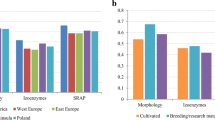Abstract
A survey of allozyme variation in cultivar-groups of cowpea [Vigna unguiculata (L.) Walp.] was undertaken by examining 21 enzyme systems encoded by 36 loci in 271 accessions representing the five cultivar-groups. Very low levels of variation were found within accessions, which is typical of self-pollinating species. Little variation was also found among accessions. Compared with other legume crops, V. unguiculata is depauperate in allozyme variation. We found an average of 1.61 alleles per locus with 42% of the loci polymorphic and a total heterozygosity of 0.061. Of the variation present, 90% was found within cultivar-groups, while 10% was among cultivar-groups. Data analyses revealed continuous variation among cultivar-groups and geographic regions with the accessions failing to segregate into discrete morphophysiological or geographic clusters. However, evolved cultivar-groups (cv.-gr. Melanophthalmus and cv.-gr. Sesquipedalis) appear to be less diverse than their putative primitive cultivar-group progenitors. Due to the lack of availability of critical material, no clear center of origin can be established. However, the data presented suggest that Northeast Africa could be a possible center of domestication.
Similar content being viewed by others
Author information
Authors and Affiliations
Additional information
Received: 18 February 1999 / Accepted: 4 November 1999
Rights and permissions
About this article
Cite this article
Pasquet, R. Allozyme diversity of cultivated cowpea Vigna unguiculata (L.) Walp.. Theor Appl Genet 101, 211–219 (2000). https://doi.org/10.1007/s001220051471
Issue Date:
DOI: https://doi.org/10.1007/s001220051471




